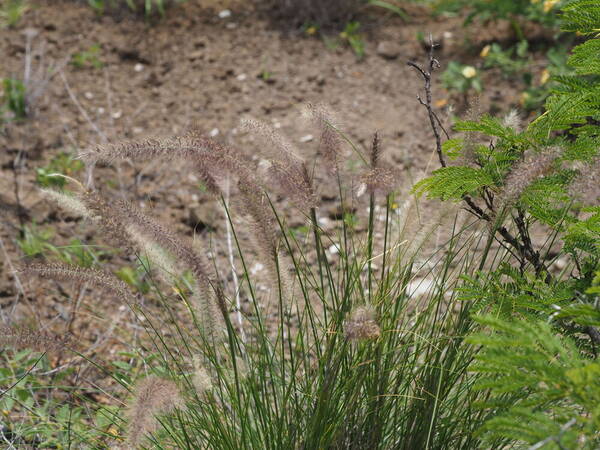Info
Subfamily: Panicoideae
Genus etymology: Cenchrus = "millet" [Greek]. However this is a misnomer, the only millet species in this genus is C. americanus, and this was treated as Pennisetum when Cenchrus was erected.
Species etymology: setaceus = "resembling bristles" [Latin] refering to the bristles subtending the florets
Photosynthetic type: C4 (warm season)
Nativity: naturalized - intentional
First recorded in Hawaiʻi: 1914
Legal status: HDOA - noxious weed
Map


Inflorescence


Plant





Habit

Spikelets




Landscape


Collar



Description
Densely tufted perennial; culms 20–130 cm. high. Leaf-blades up to 30 cm. long and 3 mm. wide, convolute with the midrib noticeably thickened on the upper surface, rigid, harsh, glaucous. Panicle linear, 6–30 cm. long; rhachis cylindrical with shallow angular ribs below the stumpless scars, glabrous to pilose; involucre borne upon a slender pubescent stipe 1–3 mm. long, enclosing 1–3 spikelets, one of them sessile the others shortly pedicelled; bristles, at least the inner, loosely plumose, the longest 16–40 mm. Spikelets lanceolate, 4.5–6.5 mm. long; lower glume occasionally ovate and up to 1/3 the length of the spikelet, usually shorter and subrotund, sometimes suppressed; upper glume 1/4–2/3 the length of the spikelet; lower lemma as long as the spikelet, ♂ or barren, acuminate; upper lemma similar to the lower; occasionally the. rhachilla prolonged beyond the upper lemma as a tiny bristle.
(Description source: Clayton, W.D. & Renvoize, S.A. 1982. Flora of Tropical East Africa. Gramineae (Part 3). A.A. Balkema, Rotterdam. 448 pp. )
Densely tufted perennial up to 130 cm high, the stems usually unbranched; leaves inrolled with noticeably thickened midrib on the upper surface, rigid, harsh, glaucous; ligule a line of hairs. Panicle linear, 6–30 cm long; rhachis with shallowly angular ribs below the stumpless scars, glabrous to pilose; involucre enclosing 1 sessile and 0–1(–2) pedicelled spikelets, borne upon a slender pubescent stipe 1–3 mm long; bristles loosely plumose, the longest 16–40 mm. Spikelets lanceolate, (4.5–)5–7 mm long; lower glume vestigial or up to 2 mm long; upper glume 1/5–2/3 the length of the spikelet; lower lemma as long as the spikelet, male or barren, acuminate; upper lemma similar to the lower.
(Description source: Cope, T.A, (1995) Flora Somalia, Vol 4. Royal Botanical Gardens, Kew, London. 312 pp. )
Densely tufted perennial. Culms 20–130 cm. high. Leaf laminae convolute with midrib noticeably thickened on upper surface, rigid, harsh, glaucous. Panicle 6–30 cm. long, linear; rhachis cylindrical with shallow angular ribs below the stumpless scars, glabrous to pilose; involucre borne upon a slender pubescent stipe 1–3 mm. long, enclosing 1–3 spikelets, one of them sessile the others shortly pedicelled; bristles, at least the inner, shortly plumose, the longest 16–40 mm. Spikelets 4.5–6.5 mm. long. Inferior glume up to 1/3 length of spikelet, usually subrotund, sometimes suppressed; superior glume 1/4–2/3 length of spikelet. Inferior lemma as long as spikelet. Superior lemma similar to inferior, occasionally the rhachilla prolonged as a tiny bristle.
(Description source: Launert, E. & Pope, G.V. (eds.). 1989. Flora Zambesiaca. Volume 10. Part 3. Kew, London. 152 pp. )
Plants perennial, or annual in temperate climates; cespitose. Culms 40-150 cm, erect, pubescent beneath the panicle; nodes glabrous. Leaves green, sometimes glaucous; sheaths glabrous, margins ciliate; ligules 0.5-1.1 mm; blades 20-65 cm long, 2-3.5 mm wide, convolute or folded, scabrous, midvein noticeably thickened. Panicles (6)8-32 cm long, 40-52 mm wide, erect or arching, pink to dark burgundy; rachises pubescent. Fascicles 8-10 per cm; fascicle axes 2.3-4.5 mm, with 1-4 spikelets; outer bristles 28-65, 0.9-19 mm; inner bristles 8-16, 8-27 mm, ciliate; primary bristles 26.5-34.3 mm, ciliate, noticeably longer than the other bristles. Spikelets 4.5-7 mm, sessile or pedicellate; pedicels to 0.1 mm; lower glumes absent or to 0.3 mm, veinless; upper glumes 1.2-3.6 mm, (0)1-veined; lower florets usually sterile, sometimes staminate; lower lemmas 4-6 mm, 3-veined, acuminate, midvein excurrent to 0.7 mm; lower paleas usually absent, if present, to 4.4 mm; anthers absent or 2.3-2.4 mm; upper lemmas 4.5-6.7 mm, attenuate, 5-veined, midvein excurrent to 0.7 mm, margins glabrous; anthers 2.1-2.7 mm. 2n = 27.
(Description source: Barkworth, M.E., Capels, K.M., Long, S. & Piep, M.B. (eds.) 2003. Flora of North America, north of Mexico. Volume 25. Magnoliophyta: Commelinidae (in part): Poaceae, Part 2. Oxford University Press, New York. 783 pp http://floranorthamerica.org/Cenchrus_setaceus )
Perennials; culms densely tufted, 2-13 dm tall, upper part scabrous, glabrous on basal portion. Sheaths 6-15 cm long, longpilose at throat, otherwise glabrous; ligule a dense row of silky hairs 1-1.5 mm long; blades rigid, glaucous, 50-60 cm long, convolute, midrib noticeably thickened on upper surface. Panicles pink to purple, cylindrical, 6-30 cm long, rachis cylindrical with shallow angular ribs, glabrous to pilose; spikelets 1-3 per fascicle, the fascicles borne on slender, pubescent stipes 1-3 mm long, each spikelet lanceolate, 1 spikelet sessile, the others short-pedicellate, 4.5- 6.5 mm long, at least the inner involucral bristles loosely plumose near base, scabrous toward apex, the longest ones 16-40 mm long, outer involucral bristles 4-12 mm long, scabrous, occasionally rachilla prolonged beyond second lemma as a tiny bristle; first glume minute, ovate to suborbicular, up to 1/3 the length of the spikelet, or absent, second glume 1-3 mm long, 1/4-2/3 the length of the spikelet, nerveless, glabrous; first lemma membranous, as long as the spikelet, 3-nerved, apex attenuate, apiculate, scabrous; second lemma membranous, 6-7 mm long, 5-nerved, apex attenuate, apiculate, scabrous; second palea membranous, slightly shorter than second lemma, inconspicuously 2-keeled. Caryopsis oblong-obovoid, ca. 2.5 mm long. [2n = 18, 27, 54.]
(Description source: O’Connor, P.J. 1990. Poaceae, pp. 1481–1604. In: Wagner W.L., Herbst D.R. & Sohmer S.H. (eds.)., Manual of the flowering plant of Hawaiʻi. Vol. 2. University of Hawaii Press & Bishop Museum Press, Honolulu )